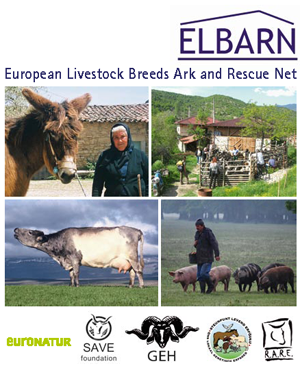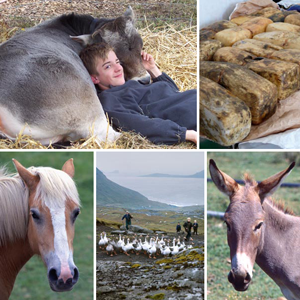|
|
|
|
 |
|
|
 |
Agrobiodiversity – a crucial part of biodiversity!
Agricultural biological diversity (agrobiodiversity) is everything – from soil bacteria through to cows and apples, including forests, rivers and wild plants – that provides our food, fibre and fuel resources. Over thousands of years humans have worked together with natural processes, selecting and developing animals and crops to provide food for a growing population.
This extremely successful enterprise has been the basis of all other human endeavours. Agriculture has provided both nutrition and time – time that was previously used on hunting, gathering and constantly moving in search of new food. The increased resources allowed humans to invent new technological processes, develop ways of organizing communities and resources, to build the wonders of the world, to think, to travel, to write music and books, and create great art. |
 |
The great diversity within agriculture was perfectly adapted for the part of the world in which it was utilized. Lambing seasons, nutritional needs, grazing technique, type of hoof – these have all been selected by farmers and evolved by nature to provide the optimal balance between production output and quality of life of both farmer and animal. This harmonious-sounding, low input, culture of managing nature – agriculture – has provided us with a vast range of animals and plants: from curly-horned sheep and goats, tiger-striped or belted cows, and pigs with wool to blue potatoes, black tomatoes and other curiosities far removed from the standardized agriculture that many of us know today. These curiosities are not, however, all extinct! Many of them live on today, even in Europe. They are kept by enthusiastic hobby farmers or in areas where traditional farming practices still exist. |
 |
This treasure chest of diversity is not only pretty, it also contains genetic resources that can provide us with security in times of uncertainty. As climatic systems change to become hotter or colder, wetter or drier, the vast diversity contained within our genetic resources for food and agriculture – agrobiodiversity – will be needed. Animals that can survive drought or can graze in wetlands whilst still producing high-quality food for human consumption will be valuable. Low input systems that do not place a further strain on already overburdened ecosystems are already being rediscovered and utilized to help protect fragile areas.
Agrobiodiversity is recognized as a crucial part of biodiversity and is protected by international agreement, as well as by European regulations and national laws. At present, plant genetic resources are more clearly regulated on an international level than animal resources. This publication concentrates on the traditional, old-fashioned animal breeds included within the range of animal genetic resources. |
|
RESCUE ACTIONS
EXAMPLE: Booted goat (Stiefelgeiss)
The Booted goat is a special breed of the Alpine goat type, found in the east of Switzerland. Its ‘boots’ are the black legs, the rest of the goat is a sandy-brown colour recognizable by its ‘coat’ and ‘trousers’, which refers to longer hair on its back and hindquarters. The breed was first officially recognized in 1909. During a phase of breed rationalization in 1938, some breeds were no longer kept but were crossbred with other, more productive breeds. The Booted goat was crossbred with two other local breeds and, supposedly, disappeared. However, the breed survived in marginal and cut off areas that were not reachable by road.
Research in the early 1980s by the Swiss rare breed organization ProSpecieRara showed that there was a large group of Booted goats in existence, on the far side of Lake Walen that was only reachable by boat. This cumbersome approach to the farm is exactly what kept the goats purebred – to load a new and valuable stud male onto a boat was too much effort, so the goats were protected from the drive towards high production.
ProSpecieRara made contact with the last remaining goatherd, an elderly lady. It was agreed that a few suitable breeding animals would be bought from her in spring 1984, to be placed in herds that appeared to have a large proportion of Booted goat blood in them. However, shortly before Christmas 1983, the goatherd suffered a stroke and was no longer able to work. Her relatives offered to, immediately, collect together the most suitable animals and have them ready to be moved within 72 hours – there was no way that they could look after the herd of goats for longer. Within two days the evacuation had been organised. Fourteen animals, eight of which were still kids, were taken in two boats across Lake Walen and to the temporary ‘rescue centres’. These ‘rescue centres’ were prepared by enthusiastic members of ProSpecieRara who were, at the time, looking for suitable animals for their farms and, luckily, had free places for the Booted goats.
Within a month of the ‘rescue action’, the animals had been split into four groups in order to prevent in-breeding and to prevent the risk of disease or other disaster affecting them. They were then placed with farmers who were interested in breeding the Booted goats into the future.
|

This scenario was a key experience for Hape Grunenfelder, who was the person responsible at ProSpecieRara for the rescue of the Booted goats. He went on to set up a network of stations in Switzerland that would be prepared to take on animals at short notice – a rescue net for rare breeds. Thus, it was possible that all interesting and endangered animals that were henceforth found in Switzerland could be adequately ‘rescued’ and secured for the future. Only one breed of sheep could not be saved – the Schwyzer Langohrschaf – due to the fact that there were no free places at the beginning of winter 1986.
The story of the Booted goat is not only a story for Switzerland – with the establishment of the SAVE Foundation, Hape Grunenfelder and his colleagues have worked towards the safeguarding of breeds throughout Europe. ELBARN is a challenging and effective attempt to spread the rescue net throughout Europe and ensure that the goal of long-term conservation of the rural diversity of Europe is secured.
StiefelGeissen-züchterverein Schweiz SGS
info@stiefelgeiss.ch
www.stiefelgeiss.ch
|
|
This text was a small excerpt from the ELBARN Book. If you are interested to get more information about agrobiodiversity, Recue Actions examples and contents of the ELBARN Project you can have a free download as *pdf ELBARN Book (5MB). If you would be interested in having printed copies of the ELBARN Book we would be happy to send you these in return for a small contribution to the postal charges. Please ask for hardcopies under info@elbarn.net
|
|
|
|
|

|
|
|
|
|
|
|
 |
|
|
| |
| Action 066 ELBARN 2007-2010 received financial support from the European Commission, Directorate- General for Agriculture and Rural Development, under Council Regulation (EC) No 870/2004 |
|
|
|
|

|
|
|
|
|
|
|
|
 |
| Elbarn 2007-2010 Partners
|
|
|
|
|
|
|
|
|

|
|
|
|
|